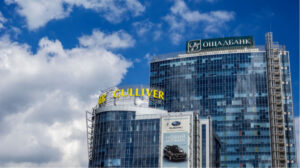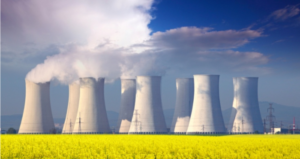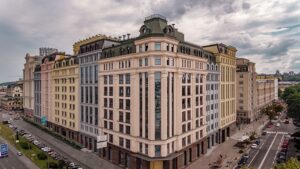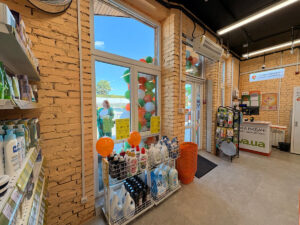
After many years of struggle, a consortium of state-owned Oschadbank (80%) and Ukreximbank (20%) has acquired ownership rights to the Gulliver retail and office complex (Gulliver Trade and Office Complex) in Kyiv, one of the largest and most expensive trade and office complexes in Ukraine, according to a statement released on Saturday by the coordinator of the Oschadbank consortium.
“After years of struggle, the state-owned Oschadbank and our Ukreximbank have obtained ownership of the Gulliver shopping and entertainment center in Kiev as repayment for the debts of its beneficiary. This is the result of the work of teams from both banks, the state, and legal advisors,” wrote Alexander Bevz, a member of Ukreximbank’s supervisory board, on Facebook.
The bank’s statement notes that TOK Gulliver served as collateral for the loan, and the foreclosure procedure was initiated due to the failure of Tri O LLC, the debtor who owned TOK Gulliver, to fulfill its obligations under the loan agreement.
Oschadbank supervisory board member Roza Tapanova noted that privatization of this asset is not possible.
“Management and sale,” she described the possible options under Bevz’s post.
In turn, according to Oschadbank, the consortium is offering all tenants of TOK Gulliver to contact Oschadbank’s legal advisor Sayenko Kharenko to re-register their contractual relationships and report that there are no legal grounds for making rent payments to the previous owner.
TOK Gulliver in the Pechersky district of the capital was opened in 2013. Its area is 151,800 square meters. The construction of Gulliver was mainly financed by Oschadbank, which provided LLC “Tri O” with a $460 million loan. The debt restructuring procedure under the loan agreement with a mortgage on TOK Gulliver in the amount of UAH 18 billion 176.9 million was completed in 2020.
TOK Gulliver was transferred to the management of the National Agency of Ukraine for the Identification, Search, and Management of Assets Derived from Corruption and Other Crimes (ARMA) by a decision of the Shevchenkivskyi District Court of Kyiv dated June 3, 2024, and the Kyiv Court of Appeal dated June 25, 2024, at the request of the Office of the Prosecutor General as part of a criminal investigation by the Economic Security Bureau (ESB) into the possible evasion of nearly UAH 146 million in taxes by TOK’s management. The BEB issued a corresponding suspicion to the director of Gulliver in May 2023.
ARMA twice announced a competition for the management of TOK Gulliver, but rejected the applications of the candidates due to non-compliance with the tender offer.
As noted by ARMA head Elena Duma, the market value of the property is UAH 7.6 billion according to an assessment conducted by an independent appraiser selected on a competitive basis, and the minimum amount of expected income was more than UAH 17 million per month.

On July 25, at the office of the State Nuclear Regulatory Inspectorate of Ukraine (SNRIU), DIARU), the official transfer of permits to JSC NAEK Energoatom for the performance of organizational and administrative functions related to ensuring the nuclear and radiation safety of Ukrainian nuclear power plants, as well as the Centralized Spent Fuel Storage Facility (CSFSF), took place.
“This stage is part of the company’s reorganization – changing its form of governance from a state-owned enterprise to a joint-stock company,” the company said on Friday.
The licenses were handed over to Energoatom’s head, Petro Kotin, by the head of the State Nuclear Regulatory Inspectorate, Chief State Inspector for Nuclear and Radiation Safety, Oleg Korykov.
He noted that the SNRIU team had conducted inspections of all nuclear facilities and nuclear power plant sites and had given a positive assessment of Energoatom’s ability to comply with safety requirements, standards, and regulations, as well as the terms of the licenses.
“Obtaining licenses to operate under the new status confirms that Energoatom retains its full powers and ensures the continuous operation of nuclear power units,” emphasized the head of Energoatom.
The changes to the licenses were made in line with the law “On the Joint Stock Company National Nuclear Energy Generating Company Energoatom” and the Cabinet of Ministers’ resolution No. 1420 of December 29, 2023. “On the establishment of the joint-stock company ”National Nuclear Energy Generating Company “Energoatom.”
Currently, Energoatom operates nine power units at the South Ukraine, Rivne, and Khmelnytskyi NPPs with a total capacity of 7,880 MW. All of them are located in territory controlled by Ukraine.
The Zaporizhzhia Nuclear Power Plant, with six VVER-1000 power units with a total capacity of 6,000 MW, has not been producing electricity since September 11, 2022, following its occupation on March 3-4, 2022.

Deputy Prime Minister for Recovery of Ukraine, Minister of Community and Territorial Development Oleksii Kuleba has agreed with Slovenian Finance Minister Klemen Boštjančič on a number of new projects to rebuild frontline regions.
“We have agreed on new projects in the areas of water supply, energy efficiency, and municipal infrastructure for frontline regions,” Kuleba wrote on Telegram on Saturday.
The deputy prime minister noted that they also discussed developing cooperation in rebuilding and supporting communities, attracting Slovenian businesses to Ukrainian projects, and strengthening technical cooperation between institutions in both countries.

Agro-industrial holding Astarta, Ukraine’s largest sugar producer, reduced its revenue from sales of key products by 14.6% in January-June 2025 compared to the same period in 2024: growth in milk sales did not offset the decline in sales across all other product groups.
According to data published by the holding company on the Warsaw Stock Exchange, in January-June 2025, the company sold a total of UAH 9.11 billion worth of its main products, compared to UAH 10.67 billion in the first half of 2024.
In particular, sugar sales in the first half of 2025 decreased by 29% in real terms compared to the same period in 2024, to 149,425 thousand tons, while the average selling price decreased by 5% to UAH 23,503 thousand (hereinafter per ton).
Astarta’s wheat sales in the first half of the year decreased by 92% to 80.33 thousand tons, while the average price increased by 4% to 8.822 thousand UAH.
Astarta did not sell any rapeseed in January-June 2025, although last year during the same period, 20.32 thousand tons were sold at a price of 18.52 thousand UAH.
Corn sales in the first half of the year decreased by 55% to 151.48 thousand tons, with a 20% increase in price to 9.722 thousand UAH.
In addition, Astarta reduced sales of sunflower seeds in January-March by 20% to 15,965 tons, while their selling price increased by 117% to UAH 28,697.
Sales of soybean oil in the first half of the year decreased by 13% to 23.72 thousand tons, while the price of the product also increased by 46% to UAH 44.7 thousand. Sales of soybean meal remained similar to the previous year at 87.76 thousand tons, while prices fell by 14% over the year to UAH 15.65 thousand.
The agricultural holding’s milk sales in January-June 2025 increased by 2% to 60.95 thousand tons, while the price of the product increased by 19% to UAH 19.28 thousand.
Overall, Astarta reduced sales of its main products by 11% in January-June: the decline in sales of wheat, corn, sunflower seeds, and soybean oil was partially offset by higher prices. The milk segment continues to show positive dynamics, with both sales volumes and product prices on the rise.

Ukraine’s real deficit to cover all military and budget expenditures, which must be covered by foreign aid in 2025-2026, is approximately equal to the 2024 figure and amounts to about $90 billion annually, according to Alexander Paraschiy, head of the analytical department at investment company Concorde Capital.
“Ukraine’s total need for external assistance, both financial and military, averages approximately $90 billion for 2024, 2025, and 2026,” he said during a discussion titled “What awaits the economy in 2025 and beyond,” organized by the Center for Economic Strategy on Friday.
Parashchiy noted that in 2024, defense and security spending amounted to approximately $95 billion, this year it is likely to increase to $100-105 billion, and in 2026, according to the new Minister of Defense Denys Shmyhal, the need could reach $120 billion.
He recalled that other state budget needs amount to approximately $42 billion, while Ukraine will be able to collect about $55 billion this year through taxes, fees, dividends, and financing from the NBU’s profits.
“That means we have a hole of about $142-55 billion, which is much more than the financial deficit figure,” the Concorde Capital analyst explained his calculations.
According to him, this need will be covered this year mainly through the EPA program (via frozen Russian assets) and the EU’s Ukraine Facility program, as well as the remainder of previously approved military aid from the United States.
“Let’s hope that the new administration (in the US) will still provide assistance under the new programs. But the biggest question now, unfortunately, is the financing of the war in 2026, because our total need for both financial and military assistance next year could reach $100 billion. And how to cover this need, unfortunately, remains a very big question,” Parashchiy concluded.
As reported, this week Ukrainian President Volodymyr Zelensky said that Ukraine needs to cover a deficit of $65 billion per year, of which $40 billion is for budget needs and $25 billion is for domestic defense production.

On July 12, Rush LLC, owner of the EVA chain in Ukraine, opened its first store of the new compact format “EVA поруч” in the village of Zazimya in the Brovarsky district of the Kyiv region, according to the company’s press service.
By the end of 2025, the chain plans to open 10 EVA Nearby stores. The next openings are already scheduled for July in the Kyiv region in the village of Sofiivska Borshchahivka (Bucha district) and in the village of Hatne (Fastiv district).
It is specified that the experimental format of the compact “EVA Nearby” store will have an average area of about 60 square meters, which is 3-4 times less than a standard EVA store.
“This format is designed to help us meet consumer needs where this was previously impossible due to a lack of space sufficient to open a regular EVA store. EVA Nearby will ensure our presence where it is important to shoppers,” said Viktor Sredniy, COO of the EVA chain.
The range will include around 2,000 SKUs (15-20,000 SKUs in full-format stores). However, the compact format will also feature unique offers with a focus on the affordable price segment. The focus of the assortment will be on household chemicals, household goods, basic childcare products, hygiene products, and body and hair care products. Decorative cosmetics and perfumes will not be available in the new format. However, the advantage of the “EVA поруч” format is that such a store will serve as a pickup point for online orders.
Investments in opening an “EVA поруч” store amount to UAH 500,000, while launching a standard EVA store costs UAH 3-5 million, depending on the design of the retail outlet, its area, and the initial condition of the premises. Each compact store creates an additional 3-4 jobs.
EVA Nearby currently has experimental status. The strategic development potential of the format will be determined by the results demonstrated, which the company plans to evaluate in 2026.
Rush LLC, which manages the EVA chain, was founded in 2002. As of early 2025, the chain had 1,109 stores in operation.
According to Opendatabot, the owner of Rus LLC is listed as Incetera Holdings Limited (Cyprus, 100%), with Ruslana Shostak and Valery Kiptika as the ultimate beneficiaries.
At the end of 2024, Rush’s revenue increased by 28.2% compared to the previous year, to UAH 27 billion. Net profit decreased by 36.7%, to UAH 1.4 billion.